|
|
|
22 August 07: Inquirer within
|
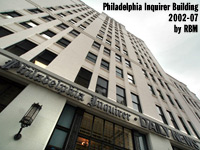 Yesterday, the not-even-rumors became true, when the Inquirer took out a full-page ad to sell its building,
the piece penned by staff writer Bob Fernandez. Actually, it's unfair of me to say it was a full-page ad since it's 2007 and like most modern Americans I read my news online. Save a tree,
read your newspaper online!
Yesterday, the not-even-rumors became true, when the Inquirer took out a full-page ad to sell its building,
the piece penned by staff writer Bob Fernandez. Actually, it's unfair of me to say it was a full-page ad since it's 2007 and like most modern Americans I read my news online. Save a tree,
read your newspaper online!
Perhaps I'm part of the problem, the problem of a dwindling newspaper readership (yeah yeah, I saw the pigs fly too) that begets dwindling revenue that begets the
sad firing of columnists and the sale of a building the newspaper has called home for over 80 years. Although if Phawker is right and Stephen A Smith's column was pulled, would anyone be sad?
One columnist who is neither sad nor fired is she who Philly Skyline apparently can't mention enough, the one who knows a thing or two about buildings for sale.
Inga Saffron has been on a roll lately, but her latest post, Also For Sale: My Shining White Knight, puts a heartfelt firsthand perspective on the Inquirer Building's impending sale.
A lot of people have been speculating since the idea of selling the building was first mentioned back in January that Brian Tierney and company will take the
cheapest offer and move the Inquirer's and Daily News' operations to the suburbs. Only he and his investors know the long term plans for sure, but I think it's
unlikely that they'll move very far.
One possibility is keeping the papers in the building via a lease to the building's new owner; another is moving them to an entirely new facility. Maybe it'll be
a combination of the two: the building will be sold and the Inquirer and Daily News will sign a short term lease to stay there -- short term because a new, modern
facility will be built at the current building's rear, at 15th & Callowhill. Maybe a sleek new tower, like the New York Times moved into earlier this year. Maybe an expansive squat building like the Chicago Sun-Times moved to when it vacated its former
site for the construction of Trump Tower Chicago. Time will tell.
The Inquirer Building as we know it isn't going anywhere, at least its place as an icon on the skyline isn't. Maybe it will join the ranks of the condo-converted
and add a giant shot to the life of North Broad Street, along with the Convention Center's expansion and whatever hotels it brings, the lofts at 511 and 640 North
Broad, and perhaps even the State Office Building which, as Inga wrote, is also for sale.
Over the past several years, I've unintentionally built a large collection of photos of the Inquirer Building. I've put the thirty best onto one page for easy
viewing; pop it open RIGHT HERE.
* * *
Well would you look at that . . . it's Hump Day. LET'S GET PUMPED! FOR AN UMPD! ATE!
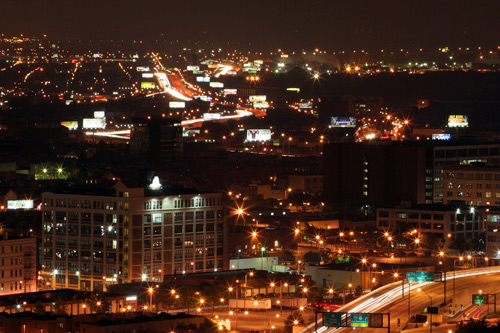
- VIDEO BILLBOARDS ARE GOOD FOR YOUR SAFETY: Safety, safety, safety! SAFETY! SAAAAAAAAFETYYYYYYYYY!!!!!!!!!!!!
If you knew what was good for you, stupid tree-hugging, view-loving, whiny liberal American, you'd quit your sniveling about the eight video billboards Clear
Channel has lined up for highways in the Del Val. Joseph Slobozian's Inquirer story has got the money quote:
"The instantaneous public-safety-messaging aspect of this technology can literally help avert disaster and save lives," [Clear Channel Outdoor's
Philadelphia Division president George] Kauker said.
All right! Never mind that the "images or ad messages that change every eight seconds" will be populated by Toyota trucks and 14 foot Wawa coffee cups and 48 foot
Fuddrucker burgers and Bernie Parent's hairpiece -- THESE BILLBOARDS WILL SAVE YOUR LIFE. Be thankful, Philadelphia -- be thankful, America! -- that we
live in a society where even the largest billboard operator in the world -- over 775,000 and counting -- is more concerned with your safety than with promoting
the Green Day concert being sponsored by Radio 104.5 (owned by Clear Channel) and whose tickets are available through Live Nation (owned by Clear Channel).
But don't take it from me or Mr Kauker -- take it from the beacon of public safety himself, Police Commissioner Sylvester Johnson:
Johnson was quoted in a Clear Channel statement as saying digital billboards were in the "community's best interests because they have the capability
to deliver important emergency information, such as Amber Alerts or disaster-preparedness bulletins."
Thank you, Commissioner Johnson!
Thank you, Clear Channel!
Thank you all, for these lovely new 14' x 48' video billboards! AHHHHHHH WATCH THE ROAD!!!
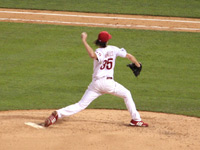 TUESDAY, AUGUST 21ST WAS UNKIND TO PHILLY SPORTS FANS: First, Jeremiah Trotter was released from the Eagles. That is a
little shocking, all things considered. Thirty is not exactly old, and Trotter is not exactly a scrub. He and Brian Dawkins ran the Eagles defense. But, business
never personal, as they say, and Omar Gaither is ready to fill some shoes and knock some heads. Fare thee well, Axe Man.
TUESDAY, AUGUST 21ST WAS UNKIND TO PHILLY SPORTS FANS: First, Jeremiah Trotter was released from the Eagles. That is a
little shocking, all things considered. Thirty is not exactly old, and Trotter is not exactly a scrub. He and Brian Dawkins ran the Eagles defense. But, business
never personal, as they say, and Omar Gaither is ready to fill some shoes and knock some heads. Fare thee well, Axe Man.
Next, Eddie Griffin died. Hard. In a death so extreme he was identified by his dental records, the troubled Philadelphia native basketball standout was killed
by a train, leaving behind all the coulda-beens of someone with so much talent and so much struggle. RIP, fella. We know you're gonna be a star in that pro
league in the sky.
Finally, Cole Hamels' elbow hurts. It hurts enough to cause him to miss tonight's start, possibly enough to miss three weeks. Just what the Phillies need on the
most important home stand of the season, hooray! Really though, did anyone think Hamels would get through the entire season without at least one little injury?
Let us hope to Baseball-God that today's MRI says only, "just take a rest kid, you'll be fine next week."
In spite of the bad news, the Phillies won a hard fought game against Los Angeles, an inspiring way to open the ten game home stand. Tom Gordon and Brett Myers
shut down the Dodger bats in the 8th and 9th, and we got to hear Chris Wheeler take his kissing-up-to-Gary-Matthews to the next level when they played a homerun
Sarge hit off the Dodgers' Jerry Reuss (who was in the Dodgers' radio booth) three times. GO PHILS.
On a personal level, it cancels my personal sixth (and probably seventh, Monday against the Mets) Hamels appearance. Because I am a jackass, I spent most of
yesterday making Excel spreadsheets of Phillies stats from the box scores of the sixteen games (not seventeen, as I'd previously miscalculated) I've attended so
far this year. (That's why yesterday only got a Comcast Center update, ha ha.) Since you are dying to know, the Phillies are an
even .500, 8-8 in my attendance in 2007. Some items of note: Hamels is 2-1 with two no-decisions, 28 Ks in 29 innings, and a 3.68 ERA; Chase Utley is batting .422
with 3 HR and 12 RBI, leading in all categories; Aaron Rowand is tied with Chase with 3 HR, is batting .300 and has been hit by 5 pitches; Ryan Howard is also
tied with 3 HR, but is batting .208 with 17 Ks and has grounded into 5 double plays (sorry, RyHo!); Rod Barajas is batting .100 with 0 RBI in eight games and
Chris Coste is batting .500 with 2 HR and 5 RBI in four games. "Gee Bee Love, thanks for sharing!" You're welcome!
- JOHNNY B'S GOES JOCK, SHOCK: A couple weeks ago, Philebrity gossed that Johnny Brenda's would have itself a
little presence at Lincoln Financial Field, just in time for the Eagles season. Then on Friday, Joe Sixpack
seconded this notion.
Dewhat?
Pardon my incredulousness, but this just seems . . . uncomfortable. As a long time supporter of Johnny B's and frequent frequenter now that I'm an official
Fishtowner, I don't question what drives them. They are a successful bar because of who they are and what they do. But The Linc?
I don't doubt that there are Eagles fans who drink at Johnny Brenda's. And I don't doubt that there are Johnny Brenda's drinkers who land themselves the
occasional Eagles ticket. (It's going to take more convincing that there are season ticket holders who drink at Johnny Brenda's. This convincing can be done on
most Mondays, when you'll find me at the bar, and only if you have an extra that I can use -- for convincing, of course -- the Cowboys game on November 4 is
preferred.)
But the whole thing just seems like a strange pairing, doesn't it? Johnny Brenda's doesn't sell Coors or Budweiser products, and it doesn't even have any TVs, let
alone multiple ones around the room showing football games. Is the goal here to bring the Johnny Brenda's crowd to The Linc? I've seen that crowd, I'm gonna guess
no. Besides, good luck getting a ticket. Is the goal here to bring The Linc's crowd to JB's? Yikes. Is the goal here to turn JB's into a cash cow? Well, fair enough,
but the Eagles only play ten games at home, and nobody attends Temple games (except for the Penn State game later this year).
Like so many weird decisions fed by success, I can only smile and nod and say "good luck." Pink Floyd responded to the success of Dark Side of the Moon by
attempting to create an entire album using household objects, then scrapped it to record Wish You Were Here. But hey. If this NFL stadium endeavor goes well, the
rumor continues, JB's will have itself a stand at Citizens Bank Park next season. And let me tell you, I would gladly alternate Schmitters and octopus plates at
Phillies games.
- IF I MAY, IDA MAE: Speaking of Fishtown favorites, tonight's the night that Ida Mae's Bruncherie starts keeping
the light on for you. That most delicious dining dwelling with an Irish aftertaste has its tables set for dinner, beginning this evening. Rainbow
trout? In Fishtown? Yes please.
Ida Mae's: 2302 E Norris St (Norris & Tulip), like two blocks from the Berks St el station. (Speaking of Speaking of Fishtown, Philly Skyline has a
Fishtown-from-the-inside spread on its to-do list, so sometime near future, we'll revisit our Fishtown neighborhood tour that's still one of our better efforts.)
- HOLY QUOTE ARCHIVE, BATMAN: There is little wisdom upon which the caped crusader has not espoused, and this Tripod web site has organized them for our benefit.
Batman: "Better put 5 cents in the meter."
Robin: "No policeman's going to give the Batmobile a ticket."
Batman: "This money goes to building better roads. We all must do our part."
Yes we must, Batman. Yes we must.
Nathaniel Popkin is doing his part; a new essay will be up later today, as will the second half of the double feature photo jawn I mentioned on Monday. Oopsie.
–B Love
|
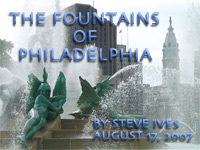 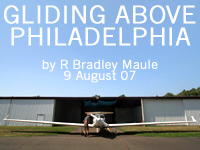
21 August 07: Raaa, aaa, aaa, aaaaaaaiiiiaa-ain
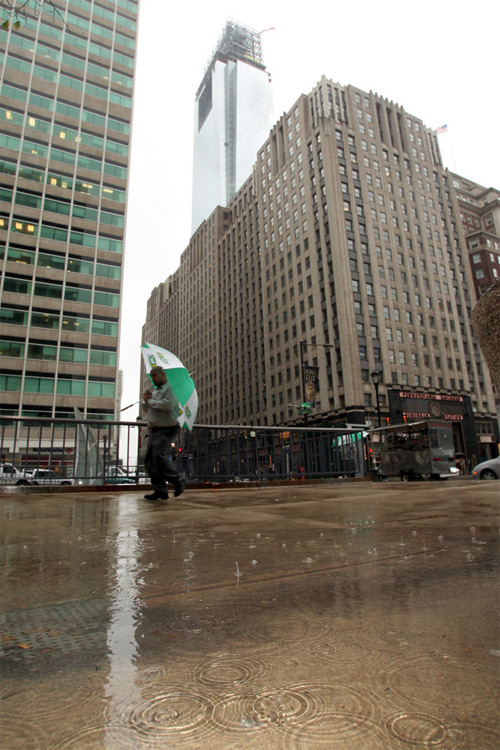
I don't mind.
Shiiiiiii, iiiii, iiiii, iiiiiiiiiiiii-iiii-iiiine.
The weather's fine.
This photo is among 19 new photos from this rainy day in our Comcast Center section. Y'heard?
–B Love
|
 
20 August 07: Let Us Spray
|
 Philadelphia has been called the "Paris of America", a title bestowed with at least some merit as this city has a storied artistic history. Some of the
nation's most reknowned institutions for theater, art and music call this city home. Beyond them, however, is the 'everyday' art - the sculptures, the
murals - that adorn countless Philadelphia streets and squares and one aspect of that public art that stays remarkably well under the radar are the
city's fountains.
Philadelphia has been called the "Paris of America", a title bestowed with at least some merit as this city has a storied artistic history. Some of the
nation's most reknowned institutions for theater, art and music call this city home. Beyond them, however, is the 'everyday' art - the sculptures, the
murals - that adorn countless Philadelphia streets and squares and one aspect of that public art that stays remarkably well under the radar are the
city's fountains.
Grand and inconspicuous, from University City to Passyunk Square, Philadelphia is a city that offers no shortage of water displays. Being founded on a
neck of land between two great rivers and owing its success and stature to its proximity to waterways, it should come as no surprise that this city is
rife with them.
While preparing for this shoot, I compiled a list of every fountain in the city of Philadelphia I could name or locate from memory. At first glance it
doesn't sound like a big job. Most Philadelphians certainly are capable (or should be) of naming as many as 7 or 8 water displays around the city, mostly
downtown. But after culling my own memory, I came up with 43 and with the help of one R Bradley Maule, got a little closer to 50 (and there are several
we both forgot, I later discovered). And these fountains and water features aren't just the kind found in the center of large parks. They can be found in
the lobbies of office buildings, the lawns and courtyards of hotels and highrises and hidden nooks of historical places. They're sometimes the white
noise that accompanies your lunch or smoke break that you rarely give thought to.
What was even more incredible than how many seem to pop out at you was how many are in disrepair or not in use at all. Apart from fountains down for
maintenance, I came across a few that had been converted into impromptu plastic forests and oscillating pylons of light and others waiting for the next
stiff wind to put them out of their misery. And would it surprise you to learn that nine of Philadelphia's ten tallest buildings - this includes Comcast
Center as of next spring - have fountains and/or water features (or used to - what's with the plastic jungle, Liberty Place?).
Now that we're in the dog days of this long, hot summer, why not take a cool break and see what's splashing around our fair town.
–Steve Ives
GO TO PHOTOS
Steve Ives is Philly Skyline's Senior VP of Transit Affairs and West Philly Warrior #1. Please check out his other waxings and musings HERE.
|
20 August 07: Tea Ess Oh Pee
|
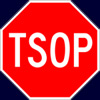 In 1973, the story goes, Chicago's Don Cornelius bumped into Philadelphia's Kenny Gamble in New York City. Don was the host of television's up-and-coming
black-oriented dance show Soul Train. Kenny was one half of Gamble and Huff, the production duo who founded Philadelphia International Records, which
ultimately took the crown of soul music from Motown.
In 1973, the story goes, Chicago's Don Cornelius bumped into Philadelphia's Kenny Gamble in New York City. Don was the host of television's up-and-coming
black-oriented dance show Soul Train. Kenny was one half of Gamble and Huff, the production duo who founded Philadelphia International Records, which
ultimately took the crown of soul music from Motown.
Cornelius had been stringing theme music together for the fledgling show when he asked Gamble to help him do a dedicated theme song. The result of the
track, recorded by dozens of Sigma Studios' musicians, was so good that Gamble had to release it as a single. The agreement was that Soul Train would
use the song as its theme, and Philadelphia International would release it without the Soul Train brand, so it was released as "TSOP" (The Sound of
Philadelphia), credited to MFSB (Mother Father Sister Brother).
TSOP's use of strings, in addition to being the theme to a tv show revolving around disco dancing, really helped make the song an early anthem to a disco
sound that didn't peak until '77 with Saturday Night Fever.
The MFSB single was a smash, knocking Elton John's "Bennie and the Jets" off of Billboard's top spot on April 20, 1974. Soul Train only kept the song as
its theme for a few years, but subsequent themes revisited TSOP (TSOP '87, TSOP '89, TSOP '93, TSOP 2000).
 The song has been covered by a number of artists -- a search for "TSOP" on itunes brings back 26 results by 10 different artists -- but the two best have
got to be those by Inner Circle and Dexys Midnight Runners. Inner Circle's reggae version mellows it down a little and replaces the strings with steel
drums. England's Dexys put a Celtic spin on the tune and even changed up the few vocals the song had. Where MFSB's version featured vocals by The
Three Degrees singing "doo doo dododo doo", Dexys' version has "ba ba babada ba" in Kevin Rowland's voice famous for "Come On Eileen". Also, where The
Three
Degrees sing "let's get it on . . . it's time to get down", Dexys' version goes "let's get this down . . . it's time to move on", perhaps an expression
of studio impatience? Who knows?
The song has been covered by a number of artists -- a search for "TSOP" on itunes brings back 26 results by 10 different artists -- but the two best have
got to be those by Inner Circle and Dexys Midnight Runners. Inner Circle's reggae version mellows it down a little and replaces the strings with steel
drums. England's Dexys put a Celtic spin on the tune and even changed up the few vocals the song had. Where MFSB's version featured vocals by The
Three Degrees singing "doo doo dododo doo", Dexys' version has "ba ba babada ba" in Kevin Rowland's voice famous for "Come On Eileen". Also, where The
Three
Degrees sing "let's get it on . . . it's time to get down", Dexys' version goes "let's get this down . . . it's time to move on", perhaps an expression
of studio impatience? Who knows?
Needless to say, TSOP is a local classic, one of a handful of anthems that never leaves the Philly Skyline central office rotation. It's also a benchmark
at Phillies games, indicating all the pregame jumbotron schwag is over, and Dan Baker's voice will soon come over the PA system to announce the night's
starting lineups.
Speaking of those Fightin' Phils, today is a rest day to allow them to think of exactly why they lost a crucial series in Pittsburgh (probably had
something to do with giving up 27 runs to a last place team) before starting a ten game home stand tomorrow.
Kenny Gamble, meanwhile, has stayed busy in South Philly, G-Ho and Center City real estate, as an investor in Dranoff's Symphony House and the proposed 777 South Broad, and with plans of his own to make South Street into an R&B mecca
centered around the Royal Theatre. The renovation of that building alone is going to be a pricey one, so here's hoping Philadelphia International
Records' rereleases and archives the Inquirer's Dan DeLuca reported last week do their part.
With TSOP, though, there's no need to rerelease, remaster or provide alternates. The original is unbeatable. It's with this in mind that I'd like to send
it home with a yank on YouTube, a full version of TSOP set to a sort of "best of" the Soul Train Line: 70s collars, 80s spandex, 90s new jack swingin',
breakers headspinnin', the robot, an indian, and . . . Rosie Perez.
We'll be back later with a brand new photo double feature, but until then . . . We wish you love, peace and soul.
–B Love
|
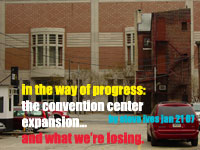 
17 August 07: NOT YOURS
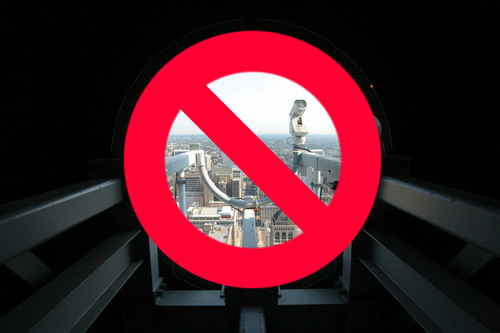
THIS JUST IN:
Remember that story earlier today where the idea was "well, it's kinda beat that City Hall observation deck will be closed, but at the same time it's kinda cool that the
interior one will be open, and when else would I get to see that?" WRONG.
It has -- this afternoon, today, Friday, the business day before this change was to happen -- been determined that the interior observation deck is unsafe and unfit for
the likes of you, or me, or the family of four from Kansas who thought seeing the city from the ONLY public observation deck in the city was a cool idea.
Details are currently scant. Whose order was it? What criteria made it fail? Was it liability fears or are we the people just stupid and clumsy?
This much is certain: less than two months into the first-ever collection of a fare for the city's only observation deck began, the collection of that money will stop for
as long as it takes the scaffolding to go up, Billy Penn to be cleaned, and the scaffolding to come back down. You figure at five bucks a tour, roughly fifteen visitors
an hour, and seven hours of operation during the day, that's $525. Times five days a week, that's $2,625. Nothing to go buying city agencies any new SUVs or anything, but
that's $2,625 a week they didn't have to pay employees before.
What a shame.
–B Love
|
17 August 07: Conventional Philadelphian Destruction
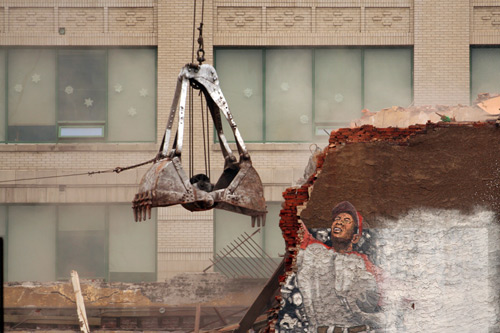
If, like any good attentive pro-urban Philadelphian, you are of the Cult of Inga, it's likely that you are aware the Pennsylvania Convention Center (PACC) is, after years of haggling, expanding. And if you're a long time (pre-Erin O'Hearn) Philly Skyline reader, you'll remember Steve
Ives' excellent look in January at the square blocks being razed to make way for that
expansion.
Well the time is upon us. On Wednesday, the Convention Center authority hung a banner high on Buck's Hardware store and ceremoniously plowed a wrecking ball through the effin thing.
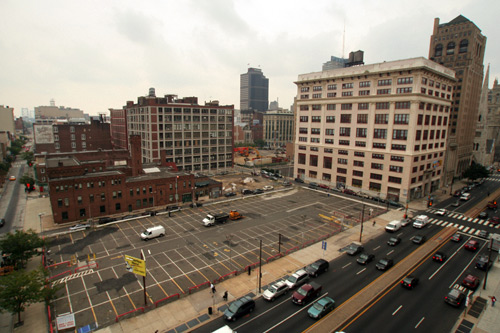
Click to enlarge and see which buildings will be demolished.
The Convention Center's expansion, like any controversy worth its salt, is a two-sided story. But, very generally speaking, it's a good thing, extremely so for the
overburdened local hotel industry.
As the PBJ reported last week,
as many as 26 (twenty-six) new hotels could pop up as a result of the $700M (seven hundred million) expansion. As a result of the expansion, our Convention
Center will jump up to 14th largest of its kind in the country, and perhaps more notably, be the largest in the mid-Atlantic region, larger than New York's Javits Center
and larger than the expanded Washington DC Convention Center.
When it's finished in 2010 (which is less than three years away ... wow, it's gonna be fun to review the first decade of the new millennium and see all the top ten lists
and see how it stacks up against the 20s and 60s), the Pennsylvania Convention Center will have over a million square feet of saleable space. Some of the larger
convention centers in the country -- Las Vegas, Orlando, Honolulu -- are in cities that live and die on their tourism, but then cities like Boston and Chicago have their
acts a little more together and host larger convention centers than ours.
Whatever the case, when it all shakes out, the expanded PACC will likely be viewed with a positive impact, its hohum architecture aside. The expos alone should be a cash
cow for Center City, and a healthy hotel industry makes for a happy downtown.
The down side is relatively minor: the 20 buildings we are losing to make way for it. There isn't anything of particular historical significance, but there are some nice
buildings -- the Gilbert Building (former home to Vox Populi), the Metzger Building, Mitchell/Giurgola's bank on Broad Street -- that it'll be sad to see go.
As with the one above, click this photo to enlarge it and see which buildings are going.
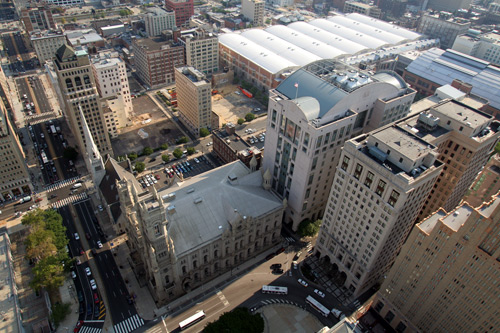
None among them, though, is as . . . cute? contextual? as the Firehouse at 1328 Race Street. The station built in 1925 was one of the central locations for the
Philadelphia Fire Department for several decades. The small structure features six gargoyles which a little Skyline birdie told me will be saved and displayed at PACC.
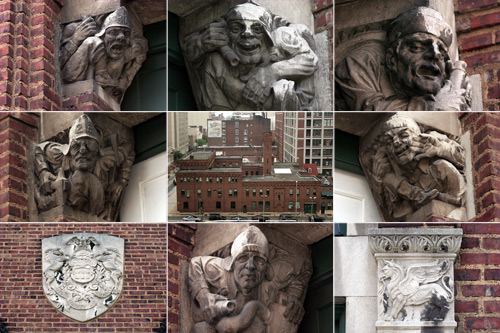
But again, on the whole, it's hard to think of PACC's expansion as anything but an upgrade (architecture aside). Save for nights with Vox openings and specials at
Edward's Adult Bookstore, the area was one of Center City's dead zones. And where the exterior of the expansion is pretty bland, the all important Broad Street side has a
nice glass wall that transitions the pedestrian into a large, well lit open space on the way to the money making bowels.
Some further reading about the Pennsylvania Convention Center's expansion:
• Blowing Up the Convention Center Neighborhood:
Inga's continued coverage of the expansion, with links to previous columns about same
• Expansion Is Here!: PACC's official web site
• If the Convention Center expands: Phillyblog discussion
• Buildings at Stake: A 2006 Daily News diagram of the buildings slated for demo
–B Love
|
 
17 August 07: Tower hour
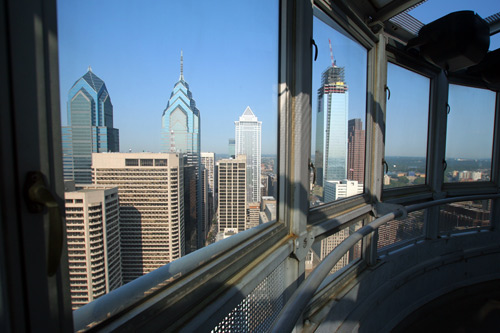
This is it, people. If you would like to enjoy this (clickable-enlargeable) view, you have to do it by 4 o'clock this afternoon. Beginning next week, City Hall's tower
observation deck will be closed for the assembly of the scaffolding to support the workers cleaning the 37 foot statue of William Penn. The cleaning is only supposed to
total 30 days, but we all know that in Philadelphia time that probably means three months.
While the regular observation deck is closed, the interior observation deck will be open. It's the part of the tower with the portholes, just below the regular
outside deck. The view is somewhat obstructed because you're physically a couple feet away from the portholes.
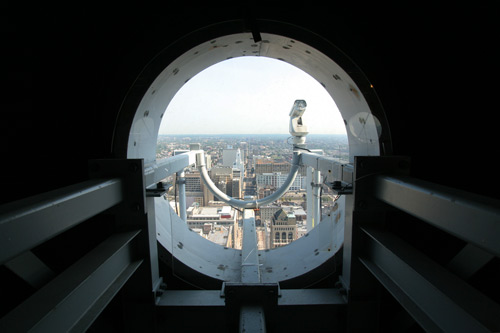
All the same, if you're one who's ever been to the regular observation deck or are just someone who appreciates City Hall, the next month presents a unique opportunity to
see the city in a different manner. Just be sure to make a list of things to look for before you go, because you'll still only get 10 minutes and you'll be craning your
neck to gaze through circles.
If you're into construction (and considering the web site you're visiting, you may well be), City Hall's observation deck is the perfect place to observe Residences at
the Ritz-Carlton rising into place where One Meridian Plaza once stood. As of yesterday, RATR-C is eight stories up, with forty to go. At 518', its finished roofline will
be just about even with the eye of the visitor at City Hall. A photo illustrating the views it will block is among the new ones in our Residences at the Ritz construction section. Its competition a few blocks west on Market Street, Murano, is also up to date.
–B Love
|

16 August 07: Long Live The King
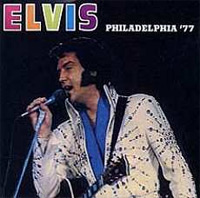 Thirty years ago today, Elvis Presley died. Or did he?
Thirty years ago today, Elvis Presley died. Or did he?
Like anybody with a decent appreciation of music, my tastes go in phases. You know those phases, where you have such an all of a sudden wild appreciation for some artist
that you go listen to their entire catalog and try to find reasons to enjoy crap like Pablo Honey and Live at Budokan (Dylan's, not Cheap Trick's). Right now, I guess I'm
in a phase one could accurately describe as "oldies", as I'm getting over my Beach Boys and early Motown hangups.
I was in my last days of drifting in summer 2000 when I visited Philadelphia, and my Elvis phase was in full swing. Mark took a picture of me leaning on the bear at Fitler Square in an Elvis t-shirt. I was out of college and unemployed, so I traveled on
the change I could scrape up from mowing lawns (seriously) and stringing pointless articles for the smallest daily newspaper in Pennsylvania. My friend Steve had recently
moved back to Tyrone after living in Memphis for seven years. He had to go back there to renew his registration and asked if I wanted to tag along. Duh.
We drove a straight shot, 18 hours and overnight, through Ohio and Louisville and Bucksnort, Tennessee before coming up on the lights of the Pyramid and Memphis skyline.
In three days, we had about as thorough a visit as one can have in Memphis: Beale Street, a walk along the Mississippi Riverfront at Mud Island, Corky's BBQ, Rendezvous
BBQ, a backyard BBQ, the Lorraine Motel (where Martin Luther King was assassinated), Sun Records, Graceland.
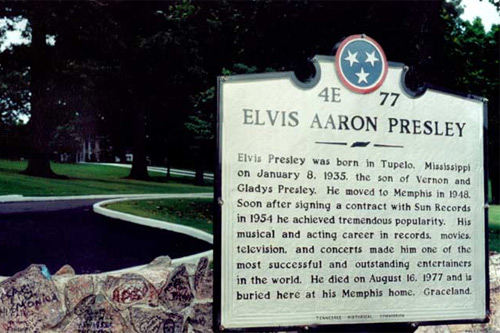
When I got to Memphis, I only knew as much Elvis as any casual observer would -- Jailhouse Rock, Heartbreak Hotel, Hound Dog -- but I'd just come across a flea market
find of the fifth disc of Walk
A Mile In My Shoes, the box set of Elvis' 70s period. I knew that the pill-poppin', Nixon-hand-shakin', suit-wearin', fat Elvis died in the 70s, but I didn't know he
had so much soul. And a sense of humor, too: in his rendition of the Righteous Brothers' "You've Lost That Lovin' Feelin'" he sings "baby baby, I'd get down on my
knees for you . . . if this suit wasn't too tight!"
Still, there's no arguing that he was a train wreck as the 70s wore on and disco and punk rendered the poor guy obsolete. Elvis squeaked in two last shows at the Spectrum
before his death, one just days before the Bicentennial celebration (during which he sported a special "bicentennial suit"), and the last on May 28, 1977, less than three
months before his death.
(SETLIST: Also Sprach Zarathustra - See See Rider - I Got A Woman/Amen - Love Me - My Way - Jailhouse Rock - You Gave Me A Mountain - O Sole Mio/It's Now Or Never -
Little Sister - Teddy Bear/Don't Be Cruel - And I Love You So - Polk Salad Annie - Early Morning Rain - What'd I Say - Johnny B. Goode - School Days - Hurt - Walk That
Lonesome Valley - Hound Dog - Can't Help Falling In Love - Closing)
It's impossible to say whether Elvis would have kept up the relentless touring if he were still alive. He'd be 72 now, and for reference, Willie Nelson is 74 and Bob
Dylan is 66. They're both still going strong. Maybe Elvis would indeed have just had an ongoing lounge show in Vegas. Who knows?
I've gotten over a lot of hangups, musically speaking and perhaps otherwise, but rightfully seeing The King for more than some manufactured pop song honky was one of the
better ones. It's true, Elvis, I can't help falling in love with you.
RIP, Elvis Aaron Presley, 8 January 1935 - 16 August 1977.
We'll do some YouTube yankin' to remember the king with this awesome performance from his Aloha From Hawaii special. You'll have to pardon the comic sans typo intro;
it's people who use comic sans that would misspell "Suspicious" in "Suspicious Minds" and say this famous 1973 show is from 1977. (Sorry.)
–B Love
|
15 August 07: Watch the BS fly
|
 Hungry after a typical morning of walking around Center City with a camera looking for new ways to see Comcast Center a few weeks ago, I stopped into Reading Terminal
Market to fill my belly with the Salumerian goodness. My previous two times there, I saw Mike Quick and Suzette Parmley (not together, though that would be pretty awesome
if they were). Wondering if I might see someone interesting on this go round, I order a prosciutto hoagie with roasted red peppers and look for a seat. Well whattaya
know, there's one right in front of Bruce Schimmel.
Hungry after a typical morning of walking around Center City with a camera looking for new ways to see Comcast Center a few weeks ago, I stopped into Reading Terminal
Market to fill my belly with the Salumerian goodness. My previous two times there, I saw Mike Quick and Suzette Parmley (not together, though that would be pretty awesome
if they were). Wondering if I might see someone interesting on this go round, I order a prosciutto hoagie with roasted red peppers and look for a seat. Well whattaya
know, there's one right in front of Bruce Schimmel.
"Hey Bruce, mind if I have a seat?"
"Sure, sure," he says, graciously interrupting his read of A Field
Guide to Sprawl to say hey. He practically gives me his copy of the book in his insistence that I read it and check out its photography. I was sold on the first
page he opened to. A Field Guide to Sprawl is Yale architecture professor Dolores Hayden's fascinating study of American excess from the air, accompanied by
stunningly beautiful photos by Jim Wark.
"What the fuck are we doing?" Bruce asks. "When are we going to put it all together cohesively, a real integration?" This quickly becomes a conversation about green
building and sustainability, peppered with anecdotes about Comcast Center and the McDonald brothers and Buckminster Green. He then gets into where this all comes from, asking simply, "wanna fly?"
Bruce Schimmel founded City Paper in 1981 on an investment. Then he was sued for more than that investment. Then get got through it, made the paper work. In '95, he took
it online to a little baby internet as City Paper Interactive, where the paper's content could permanently reside and where people could discuss it, BBS style. Then he
sold that paper and bought a plane. (He's still Editor Emeritus at CP, and his column appears regularly HERE.)
About ten years ago, Bruce decided that planes were too fast and left too big a footprint. (And who wants to pay for all that fuel at six bucks a gallon?) So he checked
out gliders . . . nice, easy, relaxing gliders. He bought an Aeromot Ximango model and is so satisfied with it that he administers a listserv for Ximango owners.
"They're the easiest things in the world to fly," he says, pausing. "If I die in the air, you can land it without a problem. If the engine goes, you have
20-some miles to figure it out because you glide."
* * *
Do I want to fly . . . Hell yes I want to fly! Bruce and I made arrangements for the morning of Thursday, August 9th. Whattaya know, my 31st birthday - it'll be a treat.
After two consecutive 100°+ days, the 9th was a relief, even at 80° in the early morning. We were to meet at 10:30, so I hit the road a half hour early, plenty of
time to spare, right? Yeah well, the first thing I did wrong was to NOT check where to meet, the main terminal of the Northeast Airport (PNE). I went to the Jet Center,
where I went for my Cessna flight in October 2003. The Jet Center's way the hell on the other side of the airfield.
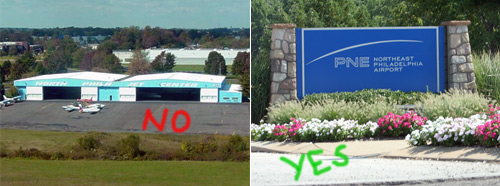
"That's ok," the guy in the Jet Center says, "just go out here, make a left, then another left, then a left onto Ashton (Road) and you can't miss it." Sounds easy enough,
but as it's exactly 10:30, I anxiously call Bruce to apologize in advance for being late. That was before realizing one left was from Red Lion onto the Boulevard, the
second deadliest intersection in the country, and the next left was from the Boulevard onto Grant Ave, the third most dangerous intersection in the country. [CBS.] Oh, and Grant Ave is all ripped to hell for maintenance, with traffic
cones and merges, rendering traffic to a standstill.
A good half hour's worth of freaking out and yelling at the back of a Septa bus and its Westrum ads later, I finally arrived, fearing that our
flight would be canceled, Bruce standing there with his arms folded and his foot tapping.
Not a chance. Bruce is one cool, chilled out dude. He's inside relaxing, with President Bush on the television. He (Bruce, not the president) is telling a guard about the
time during the 2000 RNC when Governor Bush told Bruce "get out of my way" in his Texas accent with a Texas smile.
"Wanna fly?" he asks me again.
* * *

On the other side of the security gates, I'm standing at his hangar inspecting Bruce's inspection of his aircraft. "What do the airplane pilots think of gliders?" I
ask.
"Oh, they love 'em," he's quick to reply. "They have significant ramp appeal."
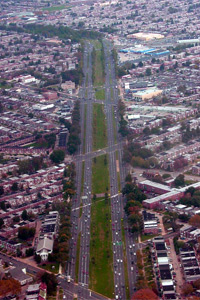 We're all strapped in now, aviator shades (naturally) and headsets ready to roll. He shows me where to keep my feet, where not to put my hands, where the barf bag
is (like I'll need that), then kindly asks that I be quiet for the taxi and takeoff as he communicates with air traffic controllers. No problem. We do those, I
giggle at all the "niners" exchanged, and we're in the air. He tells the controller that we're going to fly above the Boulevard to the Schuylkill River, where we'll hang
a left and head down to South Street Bridge for some revolutions and photos. Good deal.
We're all strapped in now, aviator shades (naturally) and headsets ready to roll. He shows me where to keep my feet, where not to put my hands, where the barf bag
is (like I'll need that), then kindly asks that I be quiet for the taxi and takeoff as he communicates with air traffic controllers. No problem. We do those, I
giggle at all the "niners" exchanged, and we're in the air. He tells the controller that we're going to fly above the Boulevard to the Schuylkill River, where we'll hang
a left and head down to South Street Bridge for some revolutions and photos. Good deal.
As soon as we're in the air, he looks over to me and smiles. I blurt out "hey, the Turnpike Bridge!" He puts his finger to his lip in a "shhh" motion just as the
controller comes over the headset again. Oops.
I shut my mouth and watch the sky blue skyline come our way, way down past Old York Road, the Logan Triangle, Temple Hospital, Temple University, and thousands and
thousands of rowhomes. Somewhere in the area above the Boulevard Home Depot, Bruce makes a photo-snapping motion and I take my camera out of the bag, 70-200mm L-series
lens already mounted and ready to roll.
Snap snap snap snap. The Wissahickon, 76's interchanges, Roxborough TV Towers, the Zoo, the Art Museum. Show me the world as I'd . . . love to see it.
Bruce volunteers a number of revolutions -- flying in circles with the wings angled at nearly 45° -- for maximum perspective. Cira Centre, UPenn, G-Ho, Comcast
Center, the Philly Skyline.
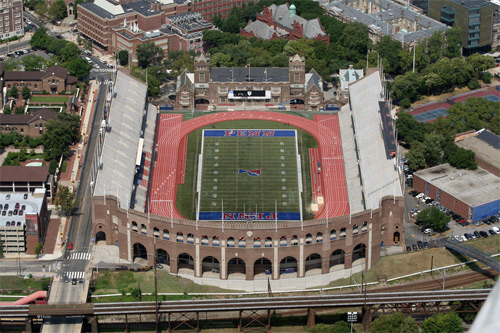
Here's where it gets a little tricky. The glider's angle allows for maximum perspective, sure, but a viewfinder barely larger than a square centimeter is what a novice
like myself might consider minimum perspective, at least peripherally speaking. Looking through an image stabilizing lens is not convincing enough to the rest of your
body that the glider is not in fact still jostling, vibrating, bouncing through the turbulence an aircraft that weighs less than a ton experiences. It is. I feel sick.
But I'll make it.
"How ya doing?" Bruce asks through the headset. "Getting some good shots?" I can only nod yes.
We've been in the air barely a half hour when we start doing a second set of revolutions near the South Street and I-76 bridges. The nausea is starting to consume me. A
gulp of bottled water helps along a built-up burp, reminding me of the two toasted coconut donuts that sat by themselves in my stomach. What was I thinking???
Blarg.
Snap snap. Gulp. Snap.
It's finally too much. "Hey Bruce, I think I may need to use that bag."
"Oh no," he says. "Here, put one of these on your tongue." He hands me a ginger Altoid. "Just let it sit there -- don't chew on it or swallow it. Take a drink of water.
Take deep breaths and put your face by the portal (out of which my telephoto had been sticking), let the air hit your face. Pick a point on the horizon and just focus
there . . .
"You wanna go home? We've got a couple hours left."
I don't want to go home, but the queasiness has consumed me. A couple hours in the air? Hell yeah . . . provided I'm not gonna puke all over the interior of someone
else's expensive aircraft. I nod yes again.
He asks again to be sure (I get the feeling he doesn't want to go back just yet), and we turn around and start back toward the Northeast. We pass Fairmount Park,
East Falls, the Wissahickon once more. We're coming up on the TV towers again, so I try taking another photo. "Better not play with fire," he advises. I look back to the
horizon.
As we're approaching the runway preparing to land, the controller asks on behalf of a circling charter plane if he's going to be much longer. "Roger that, these (gliders)
only go so fast." Ain't that the truth.
* * *
Back on the ground and now at Albert's Cafe, I recover with a bad caesar salad and a Sprite. Should've gotten a ginger ale, duh. Bruce's tuna salad looks much better. We
pick back up on perspective and I think about things I could do differently. Not go on a mostly empty stomach, for starters, much less on a healthy helping of Dunkin.
Consider cutting the haze with a UV filter, which I usually vehemently oppose. (I like my glass to be as unobstructed as possible for the clearest photos possible.)
Maybe pause between every 10-15 pictures to focus on the horizon.
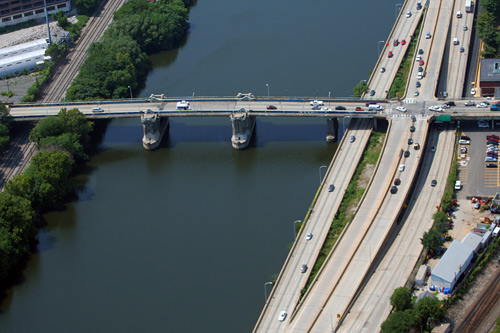
We chat a little more about green building and its fight for the future in Philadelphia, a little about the South Street Bridge, and a little about Mark before our perfectly Northeast Philly young waitress brings us the bill, which I happily (and obviously) grab.
"Send me a link to those pictures, and invite me to parties!" he says as we head outside. "Oh and hey, happy birthday!"
Thanks, Bruce.
* * *
CLICK HERE to launch aerial photos.
PLEASE NOTE: there are no captions yet, but there will be as soon as I can write em up.
–B Love
|
15 August 07: Who am I?
Go on, guess! You can do it!
–B Love
|
15 August 07: Echoes
SPACE HOLDER SPACE HOLDER GO GO GO
|
14 August 07: Rollin' with Olin on the plaza
|
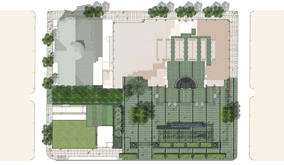 Philadelphia's Olin Partnership is not synonymous with landscape architecture, it is landscape architecture.
Philadelphia's Olin Partnership is not synonymous with landscape architecture, it is landscape architecture.
The populated promenade at Battery Park City in New York? That's theirs. The Canada Square plaza amongst London's reborn skyline at Canary Wharf? Theirs. Salt Lake City's
green roof so enormous it would fit a 747, but neither the 747 nor you nor I will see it unless you or I are members of the Church of Jesus Christ of Latter Day Saints,
because that's whose roof it is? Also theirs.
In their hometown, Olin Partnership is probably most famous for being Ed Bacon's enemy. The reconfiguration of the mall at Independence National Historical Park -- over
which Olin's office at the Public Ledger Building looks -- is, love it or hate it, finally taking shape through Olin's vision. Bacon, who championed a mall decades before
Olin took over the project, was so opposed to Olin's design that he circulated fliers proclaiming that Olin wanted to ruin the Mall.
The Mall may be Olin's highest profile project in Philadelphia, but it's hard to miss their other work; The courtyard at Commerce Square. The redone and replanted Logan
Circle. The World of Primates at the Zoo. They're currently working on the landscaping that will do its best to mask the parking garage behind the Philadelphia Museum of
Art, as well as an embellishment of the grounds inside the Rodin Museum.
They're also responsible for the public plaza at Comcast Center.
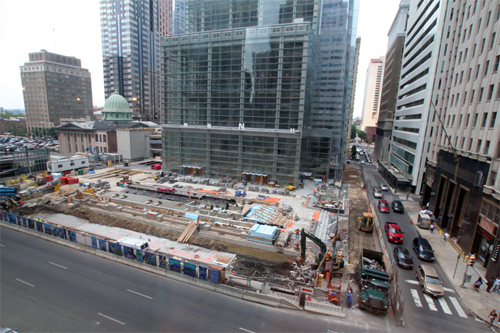
The architecture of skyscrapers is often best judged from afar; the admiration of a skyline's massing always so. But how skyscrapers actually perform and function within
the city they represent can only be seen on the ground. Olin firm partner Cindy Sanders was kind enough to share how Comcast Center performs and functions on the ground,
and Senior Landscape Designer Eve Kootchick elaborated the plaza's plentiful intricacies.
Trellises, cafés, a plinth and some benches. ADA ramps, stairs, a fountain with trenches. Dichroic glass, hedges, trees flowering. These are a few of my favorite
things going on at Comcast Center's plaza, under construction at this very second. Every last one of these things had to be intricately examined and weighed before
implementation was even a thought, for after all, the plaza rests over the city's arterial regional rail lines -- eight train tracks wide -- and the concourse between
them.
"We used Bryant Park (in New York, whose award winning design is Olin's) as a precedent," explains Sanders. "It's built over structure and it holds a lot of people,
including dining."
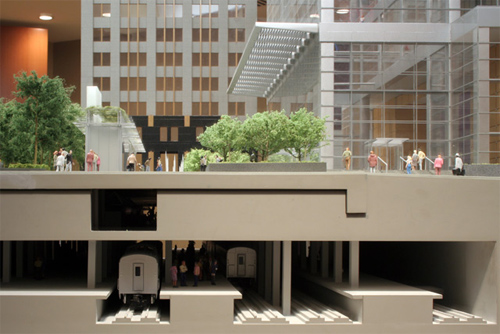
From the top down, it goes plaza, concourse, platforms, tracks. On the plaza itself: granite, mortar, concrete, insulation, and foam blocks which help to lighten the
load. The concrete layer has an elaborate maze-like piping system which utilizes heated recycled water to act as a snow-melting device during winter months.
From above, the plaza looks to employ half a dozen different types of granite, but in actuality there are only two -- atlantic green and forest green -- and it's the
finishes that give them their different hues and shades. All of the plaza's granite comes from the same quarry in La Croix, Québec that provided the stone for
Washington DC's World War II Memorial.
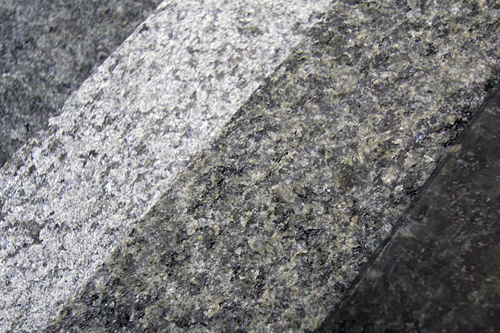
Kootchick laid out the samples you see there and demonstrated that there are six finishes, "rough to smooth, light to dark." The smooth, polished finishes will accent the
lobby floor, including the grand staircase from the Suburban Station concourse and its little brother stairway along Arch Street, while the rougher finishes punctuate the
outdoor plaza.
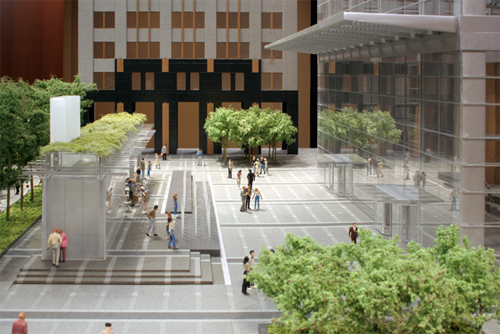
In the model above, you can see darker bands of granite moving from the building toward the raised trellis and plinth. These bands follow the steel columns of the tower,
extending Comcast Center's symmetry further outward. They then step back up to the trellis, under which the café by Georges Perrier & Chris Scarduzio (not to be
confused with Table 31, their restaurant on the first floor inside the tower) will sit.
The café's kitchen stands as a multi-colored cube on the eastern end of the trellis, and doubles as the exhaust housing for the concourse below. Tables will sit
beneath the trellis, made of steel columns and laminated glass beams across the top. These glass beams are 8" thick with fins on the ends, and will be colored in the
range of blues and purples. Dichroic glass, an expensive model which changes color depending on the light (think the pillars at Broad & Washington, only less 80s)
is being considered.
Between the trellis and the entrance to the tower is a fountain fashioned by Wet Design, the California firm
responsible for the fountains at Bellagio in Las Vegas. If you've seen the fountain at PPG Place in Pittsburgh, think of Comcast Center's as a smaller, but more
contemporary, version of that, with children running through it freely because it is open. It has three rows of jets which can be choreographed, which are lit from
below, and which change colors. The trenches under the fountain collect the runoff (easy to do since the water shoots straight up) and reuse the water. The fountain also
uses a portion of stormwater runoff from the tower.
Along JFK Boulevard, sculpted carpinus trees (currently being grown at a nursery in South Jersey) will not only provide shade to the benches that run along the plaza's
outer perimeter, but they will mask the view directly out of the building into the less attractive parking garage access of 6 Penn Center.
"JFK Boulevard has always intended to be grand," Sanders explains with photos of the Suburban Station building, Love Park and 30th Street Station, "but it hasn't done
well with the pedestrian experience." Considering the plaza was a block-wide parking lot just over two years ago, she's right.
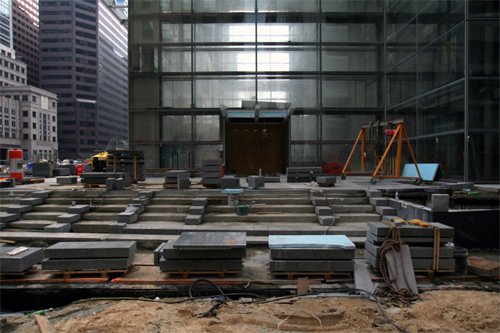
The pedestrian experience on 17th Street is much better, too. Stairs follow the descending grade toward Arch Street, and a grouping of flowering trees welcomes the
pedestrian from mid-17th Street up the stairs to the entrance of the building. These trees, as well as some cherry trees, are replicated on the opposite side of the
plaza, and there is a passageway of trees along what was once Cuthbert Street, between Arch Street Presbyterian Church and what will eventually be the shorter second
tower. Kootchick admits, "this is probably my favorite part of the project. It's much more intimate and quiet; it's a nice counterpoint to the lively plaza."
Oh yeah, the second tower; phase 2; Two Pennsylvania Plaza. While it's not a 100% certainty, the folks at both Liberty and Olin speak of it in terms of when, not
if. Rumor has it that the tower, which was to mimic Suburban Station's form, is being actively reworked by its architect Robert A.M. Stern. In the interim, a
two-tiered green roof will stand in its place and accommodate a headhouse to the concourse. The problem with planting this Cuthbert section of trees now, though, is
that, should that second tower become a reality, it will need a staging area, and with the main part of the plaza already being open by then, this is the only real
estate left. So this miniature grove will happen, but when it happens depends on the second tower.
There's a lot going on for a single new city plaza, that much is evident. What remains to be seen, though, is whether the plaza will be of the exciting urban variety,
like Love Park, or of the empty and wind swept variety, like Penn Center. Wait a second, those are each Ed Bacon's!
Bacon was downright repulsed by Olin's Independence Mall, and he was among those leading the charge to keep the Philly Skyline below Billy Penn's hat, so chances are he
wouldn't have been a fan of this plaza under a building nearly twice the height of City Hall. But then, he's in a better place than we are, so who are we to even guess
what he would have thought? Let's judge it for ourselves when it's open next summer.
[Olinptr.com: Comcast Center.]
* * *
This is probably a good a time as any to mention that yr Philly Skyline Comcast Center section is now current with an up to date
diagram and over 30 new photos. Those photos include a peak into a feature that's premiering tomorrow. They include this, your sneak preview Philly Skyline Philly
Skyline.
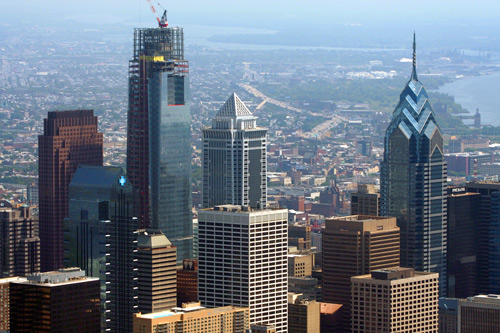
If you notice that that aerial is current, then you are not ESPN. Their coverage of Sunday night's game was absolutely atrocious, and included aerial footage from
November 2005 which led to one of countless stupid discussions between Jon Miller and Joe Morgan (who, by the way, hit a career-low .230 in his one season with the
Phillies). The fly-by was completely devoid of Comcast Center and saw One and Two Liberty Place and Mellon Bank Center lit up in their pink and baby blue premature birth
awareness schemes. It took those two idiots' rambling on (and on and on and on) about Barry Bonds (and actually showing the Hank Aaron jumbotron message -- with
not so much as a window-in-window -- while the Braves were batting and indeed scoring) and a pointless interview with John Smoltz about Tiger Woods to make me
actually miss the voice of Chris Wheeler. Ay carumba.
The Phils hit the road this evening for three in Washington and three in Pittsburgh. Two weeks ago, we took five of six from those teams, so here's hoping for a repeat
performance. LET'S GO PHILS.
–B Love
|
13 August 07: The Philly Skyline Book Review:
Walking Broad by Bruce Buschel
|
Walking Broad, by Bruce Buschel
Simon and Schuster, 2007, 224 pages
ISBN-13:978-0-7432-9284-9
Reviewed by Nathaniel Popkin
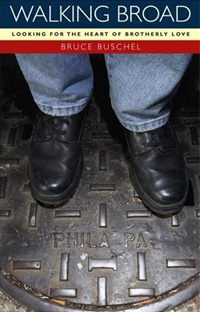 My friend Peter Siskind and I invent long city walks across city neighborhoods, time, and cultures. Or, borrowing from the author Will Self, we consider walking out of
Philadelphia and continuing to New York—anywhere really. "How cool would that be," he says, imagining navigating the towns, highways, and strip malls of the
Northeast Corridor. (Much of his research as an historian is on the post-war development of the Northeast.) "Fascinating," I always reply and our eyes shine a little
and then we go back to talking about the Phillies. Inventing such journeys isn't new to Siskind, who with his wife Judi Cassel, once biked across the country; nowadays
he'll spend Sunday mornings with Leo, their son, riding across Philadelphia on "bus adventures." For example, they'll take the 48 from their house in Fairmount to the 26
on Olney Avenue to the H in Germantown, returning on the 33. This is how both father and son have learned every Septa route, nearly every inch of their city—and not
surprisingly each other.
My friend Peter Siskind and I invent long city walks across city neighborhoods, time, and cultures. Or, borrowing from the author Will Self, we consider walking out of
Philadelphia and continuing to New York—anywhere really. "How cool would that be," he says, imagining navigating the towns, highways, and strip malls of the
Northeast Corridor. (Much of his research as an historian is on the post-war development of the Northeast.) "Fascinating," I always reply and our eyes shine a little
and then we go back to talking about the Phillies. Inventing such journeys isn't new to Siskind, who with his wife Judi Cassel, once biked across the country; nowadays
he'll spend Sunday mornings with Leo, their son, riding across Philadelphia on "bus adventures." For example, they'll take the 48 from their house in Fairmount to the 26
on Olney Avenue to the H in Germantown, returning on the 33. This is how both father and son have learned every Septa route, nearly every inch of their city—and not
surprisingly each other.
For Bruce Buschel, walking the length of Broad Street (an urban hike worthy of a Skyline photo essay) is deeply personal, too. If the bus adventures are a giant
inhalation (of street corners, routes, bus drivers, passengers, time together) then Buschel's walk is the equivalent exhalation, and here on 224 pages is everything about
his native city he had to get off his chest. Buschel, the 61-year old journalist and filmmaker, grew up and lived in Philadelphia until his thirties. Broad Street was
his street of misbegotten dreams.
At the start of Walking Broad, Buschel quotes Stephen Berg, the Philadelphia poet and founder of the American Poetry Review.
Everything stays the same is the truth of truths;
Everything changes whether you believe it or not.
Berg's wisdom is the frame for Buschel's project. And Buschel wants to accept it. He's looking for change, after all, and is effective and entertaining in describing
it. But in the end, he doesn't believe his old city has changed—is always changing—and this is perhaps what is most disappointing about Walking
Broad.
Buschel is a clear, honest, and funny writer, which makes Walking Broad a great read.
Coming back from a Phillies game or following s successful night at Mosconi's pool hall, around ten or eleven, we'd cruise up and down this stretch of Broad
Street and spy a tomato in a short skirt—Eliot called them tomatoes, hothouse, farm-ripened, or heirloom, anything but cherry, and never Jersey—and Eliot would
signal her with a hissing "Pssst! Pssst!" Pushing wet air in short truncated streams through your closed front teeth made a sharp, vaguely sexual sound that could
perforate any night. "Pssst! Pssst!" The tomatoes would walk over to the car to negotiate.
"How ya doin', babycakes?" she would ask.
"You got some time for us?" Eliot would ask back.
"You wanna go 'round the world?"
"How much for a blowjob?" he would ask.
"You a cop, baby?"
"Do I look like a cop, baby?"
"No, baby. I jest gotta ax."
Along the route south he calls his brother in California several times, calls up memories and conversations, and quotes notes and e-mails. He covers obesity, gun crime,
poverty, abandonment, education, and the fall of newspaper journalism. He travels the Philadelphia landscape, from the Lenape to Penn, Girard to Steven Starr, Joe
Frazier to Lew Blum, Haym Salomon to Kevin Bacon and his dad. Though he's been a New Yorker for 25 years, Buschel can get to the heart of the Philadelphia matter with
ease, perhaps without even realizing he is doing it. He is marvelous chatting with the manager of the Earl Scheib shop, describing the service at the Chinese Mennonite
Church, playing the fool with the Chief Operating Officer at CHOP (trying to understand how the great children's hospital can have a McDonald's), listening to a sock
vendor describe his theology—
At the corner of Broad and Indiana, in front of a small shopping mall, I pass a chubby black dude hiding behind sunglasses and a black baseball cap.
"Socks," he says. "Six pair for five dollars."
I'm set with socks, so I just walk on by. Halfway down the block, I think maybe it's not socks he's selling, maybe a euphemism, a street code for some other contraband,
something more imaginative, perhaps imported. What the hell.
"Socks," I ask, eyebrow raised steeply.
"Socks," says the man.
"Where are your socks from?"
"Heaven," says the vendor.
"You got socks from heaven?"
"Direct from heaven," he says.
"How did they get to you?"
"I am blessed, brother, blessed."
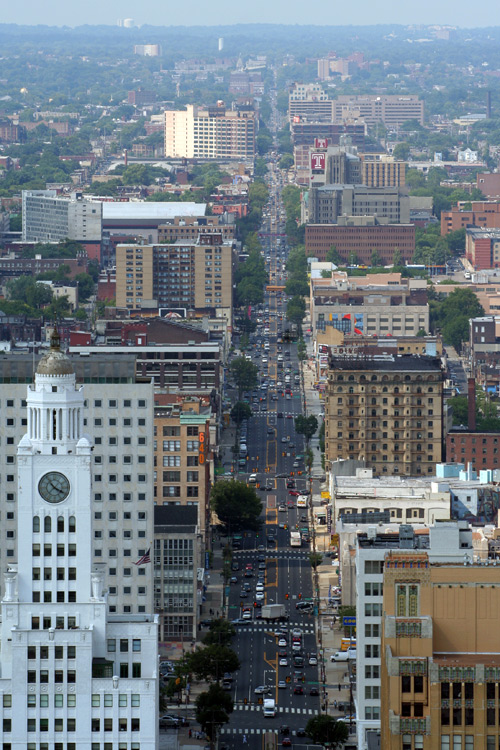
Buschel's prose moves quickly, moving on a dime from the street corner to the crevices of his memory. There, he often finds his mother, in a house in Logan (since
demolished), widowed with two children, and a habit of bringing scotch to bed at night. I'm reminded here of the poet Berg's grappling with the relationship with his
mother, which he does throughout his work, most directly in The elegy on hats. The two men share enough in common, growing up in working-class Jewish homes in
Philadelphia with dissatisfied mothers and fathers who eventually drop dead. Buschel grew up during an ugly time in urban America. Crime, abandonment, and poverty
skyrocketed. Traditional ties broke down once and for all. Neighborhoods changed quickly. Viet Nam left ample scars. Buschel thinks—and why shouldn't he—that
all this was particularly hard-felt in Philadelphia, that therefore growing up in Philadelphia was somehow more brutal, potent, mind-addling than anywhere else. But for
all Philadelphia suffered—the '64 Phillies, Rizzo, racism, MOVE—New York had the Son of Sam, the blackouts, Sing-Sing, Bronx burning. For all that Buschel was
piddled at Girard College, priests in Boston were dementing their altar boys. Even Paris lost population. London still hadn't recovered from the war.
If you think growing up in an insecure, violent city under attack from without and within, by simpleton police chiefs and pyromaniac mayors and mad-dog media and
manic-depressive stand-ups and cuckolded uncles and the fat, unshaven newspaper dude down the corner doesn't take a toll on your soul, you are not a
Philadelphian.
But Buschel thinks decline, misfortune, and pervasive depression are the only ways to understand his city. Because of that—because he doesn't really believe things
change (in many directions at once)—he shrouds his fast-pace jaunt down Broad Street with the usual, tired narrative frame: Philly is a rest-stop between New York
and Washington, a "'taint," "a small town hiding as a big city," full of authentic, impolite people. Here we get the MOVE bombing, the ridiculous accent, the failure of
our sports teams, the Philly dance of death, the post 9/11 renaissance (uh-huh, Philly only woke up in 2001. Please, Bruce). We get the usual vaguely truthful but
suspect observations: Philadelphians don't take public transportation (Septa reports a million rides a day); Philadelphians never say, "Have a nice day" (Bruce, no one
ever told you, "Hafa goot wun"?), we hear from Josh Olsen, a screenwriter, "The only really smart thing I ever did concerning Philadelphia was leave," "Philly is a city
for idiots. Linear, rectangular, straight ahead." Are we supposed to forget the grid was a great act of the enlightenment or that his description would fit Manhattan
too? Gee, I bet he wouldn't say, "New York is a city for idiots."
The frustrating thing is that Buschel makes it clear he understands. His research is thorough. He knows that what differentiates Philadelphia during the time of his
growing up is that foreign immigration, which began declining in 1910 only began to recover in the 1980s, and slowly at that; that immigrants are the lifeblood of
American city. He understands this, implicitly recognizing the importance of the ongoing wave of Mexican immigration (immigrants as a percentage of overall population
are now back to the 1950 level and rising). But he wants us to think Philadelphia hammers everyone who comes here into a kind of dull daze, capable of spelling
E-A-G-L-E-S in unison a little else. This is authorial murder: trampling a million little narratives into one.
That's his prerogative, I suppose, it's his exhalation. I just wish he'd held his breath a little more and written with his eyes and ears instead.
–Nathaniel Popkin
nrpopkin@gmail.com
For Nathaniel Popkin archives, please see HERE, or visit his web site HERE.
For more on Walking Broad, visit your local book shop -- how about Joseph Fox Book Shop or Robin's Bookstore?
|
|









